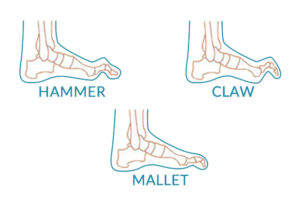Foot - toe deformities
What are toe deformities?
There are 3 bones, called phalanges, in each of the lesser toes (the big toe only has two) which should lie flat in a straight line. There are tendons running above and below these bones which enable you to bend and lift your toes. If the muscles of these tendons are out of balance they will tighten excessively, contracting the tendons, which pull one or all of the bones out of position and thus forcing the joints to bend. The joints then rub against your shoes forming painful calluses, and making walking uncomfortable. Eventually the bones become set in the abnormal position, and surgery is required to correct them. The main deformities are as follows:
- Hammer toe – the first bone or phalanx is pulled upwards, the second tilts down, and the third is almost flat
- Claw toe – the first phalanx points upwards, but the second and third point downwards, making the toe curl like a claw
- Mallet toe – only the tip of the toe (third phalanx) is pulled downwards whilst the first two bones are in line.

What causes them?
Toe deformities can be caused by shoes that are too tight, particularly if they have high heels or are pointed, and as a result, they are much more common in female patients. Hammer toes in the second toe are often caused by bunions (see Hallux Valgus) as the big toe pushes the smaller toe out of position. However they can also be caused by other foot abnormalities such as flat feet or high foot arches (pes cavus), or be the result of injury or an underlying nerve disease.
How do they feel?
The calluses that form on the deformed joints and/or the tip of the toe will be painful, and the toe may become inflamed.
Diagnosis
Your doctor will be able to diagnose a toe deformity simply by looking at your foot, although he may ask for X-rays to show the exact position of the bones, and to see if there are other problems in the rest of your foot.
Treatment – conservative
If the deformity is diagnosed early enough, changing the type of shoes you wear so that they fit properly, and using pads to relieve pressure on the calluses may be sufficient to treat the problem. However, if the problem is more advanced, you will need to have minor surgery to correct it.
Treatment – surgical
– Arthroplasty: your surgeon will make an incision along the top of your toe. He will then tighten or loosen the ligaments and tendons as necessary, re-balancing the soft tissues to allow the toe bones to straighten. Then he will remove the end of the bone to allow the joints to flatten. The joint will then be held in the correct position by a wire, which will be removed after 4 weeks.
– Arthrodesis: in older patients when the deformity has permanently disabled the joint, your surgeon will fuse the bones together. He will remove the cartilage from the ends of the phalanges (normally the first and second), and press the two bare bone surfaces together, fixing them with a removable pin. Over time, the bones will grow together to form a single bone.
Rehabilitation after surgery
You will need to wear a special post-operative shoe after the operation which stops the foot from bending for the first month. If your toe has been fused, you will need to walk with crutches for the first month.
When will I be back to normal?
You can start driving again when the pins or wire fixations have been removed – normally after a month. Office workers can go back to work after 7 days, manual workers after 45 days. You can return to full sporting activity after 2 months.